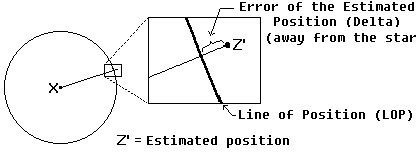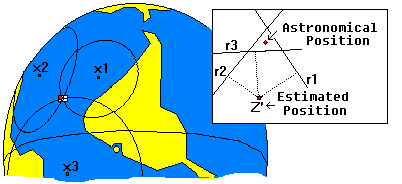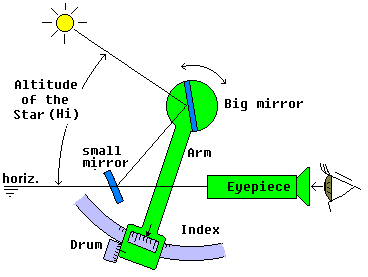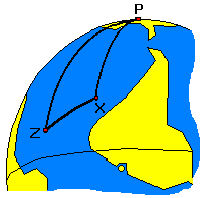<< previous page
|
|||||||||||||||||||||||||||||||||||||||||||||||||||||||||
| Because a Geographical Position of a star is normally thousands of miles from our position, the circle of position is very large and the small piece that interests us - the one near our position - may be considered a straight line, orthogonal to the Azimuth of the star. This line is called the Line of Position or LOP (fig. 9). |
 fig. 9 - Line of Position |
We managed, from the measured altitude of a star at a certain time and our assumed position, to draw a line of position. We know that our actual position is somewhere along this line. To determine this point we can draw another line, for another star. The point were they intercept each other is our position - or our Astronomical Position.
 fig. 10 - Triangle formed by the intersection of three lines of Altitude |
Normally, the navigator should repeat this procedure for yet another star, just to be sure. Since measurements are affected by minor imprecisions, the three lines will probably not intercept in a single point, resulting in a small triangle. Our position is probably in some point of this triangle (fig. 10). The smaller the triangle, the better. We usually assume that our Astronomical Position is in the center of the triangle. |
In figure 10 above, we can see how three circles of position determine 3 Lines of Position r1, r2 and r3.
|
In traditional celestial navigation the determination of a Line of Position involves the computation of the GP of the star (GHA and declination) using the Nautical Almanac and the solution of the Position Triangle PXZ, formed by the terrestrial pole (P), the GP of the star (X) and the assumed position of the navigator (Z) (see fig.11). This solution, using tables, yields the Calculated Altitude and the Azimuth of the star. The difference, in minutes of degree, between the calculated altitude and the altitude of the star measured with the sextant is the distance between the line of position and our assumed position - the error Delta of our estimate. This can be away or towards the star. |
fig. 11 - Triangle of Position PXZ |
Using Navigator software, the GP of a star and the triangle of Position are solved by the computer using formulas. All you will have to do is enter the sextant reading (date, time and altitude), name of the star and the assumed position (latitude and Longitude).
Determination of the Astronomical Position
It's not necessary to draw the lines of position when using Navigator software. But let's see how this is done using pencil and paper:
- Plot your assumed position.
- Using a parallel ruler, draw a line passing on the assumed position, in the direction of the Azimuth of the star.
- Over this line, measure the error Delta of the estimate - in the direction of the star or contrary to it - according to the sign of the Delta.
- Draw the line of position, orthogonal to the Azimuth, at this point.
Detailed Nautical Charts are usually only available for places near the shore. When in high seas, we normally don't have charts with the adequate scale to plot our position. Special plotting paper is used instead.
When navigating using Navigator software, the computer determines the altitude lines interceptions and calculates the astronomical position. A simplified map is drawn, showing the parallels, meridians, lines of altitude and the astronomical position.
The sextant
| The sextant is an instrument that measures angles. Fig 12 shows a schematic sextant. The eyepiece is aligned to the small mirror, which is fixed in the frame of the instrument. This mirror is half transparent. By the transparent part, the navigator can see the horizon directly. The small mirror also partially reflects the image from the big mirror, where you see the star. The big mirror is mobile and turns with the arm of the sextant. Doing that, we change the angle between the two mirrors. The altitude of the star is measured in the scale. There is a drum to make the fine adjustments. Whole degrees are read in the scale and the minutes in the drum. |
 fig. 12 - The Sextant |
sextant working model (requires Flash
5.0 plug-in)
The sextant has two sets of filters (or shades) to eliminate the excess of light, especially when observing the Sun. The use of two or more filters in front of the big mirror is necessary when observing the Sun. Serious eye injuries will result from observing the Sun without filters, even for a brief period.
 fig. 13 - Image of the Sun in the sextant |
When looking through the eyepiece and adjusting the sextant, you will see something like figure 13, to the left. Sextant readings must be made with the sextant in the vertical position. Inclining (rocking about the axis of the eyepiece) the adjusted instrument slightly, the image of the celestial body describes a small arc that touches the horizon in a point near the center of the mirror. In this situation, the angle is ready to be read in the instrument scale. |
Altitude corrections
But before we can use this apparent reading in our calculations, some corrections must be made, in order to obtain the true observed altitude. These corrections are: 1) the height of the eye, 2) semi diameter of the body (only for Sun and Moon), 3) instrumental error, 4) atmospheric refraction and 5) parallax (only for the Moon).
Since most of these corrections depend only on the selected celestial object and altitude, they are performed automatically by Navigator software. The only information you will have to provide to the program are the height of the eye (a.k.a. Dip) and the instrumental error. The application of these corrections to the instrumental altitude gives the corrected altitude, the one used in calculations.
| An observer located in a high place will see a star with an altitude bigger than other at sea level, in the same location. This error is called height of the eye (Dip). |
 fig. 14 - Error due to the height of the eye (Dip) |
 fig. 15 - eyepiece image of the sextant index error |
The sextant index error (IE) is due to a small misalignment of the scale of the sextant (the "zero" of the instrument). To read the index error, adjust the scale to 0°00.0' and point towards the horizon. In fig. 15 left we can see this error. Turn the drum until the horizon forms a single line (fig. 15 right). Then you can read the index error. |
 fig. 16 - Sign of the instrumental error |
The index error can be positive or negative, as shown in fig. 16. The index correction has opposite signal (i.e. must be subtracted from altitude if positive and vice-versa) |
|
Parallax error is illustrated in fig.17. Since the navigator is not in the Earth's center, but in its surface, the apparent object position is below the true geocentric position. Parallax is only meaningful for the Moon. Other objects are so far, their parallax is very small.
|
fig. 17 - Parallax in altitude error |
| Nautical Almanac data is tabulated for the centers of the celestial objects. For the Sun and Moon, however, it's easier to measure the altitude of the lower part of the body, as illustrated in fig. 18. This is known as the lower limb. Of course a correction must be applied in order to obtain the altitude of the center of the body. This correction is called semi diameter. Sometimes, the upper limb is also used. |
 fig. 18 - Semi diameter correction |
Now that you know how celestial navigation works, take a look in the Navigator software manual.
---xxx---
Bibliography
| >> "Celestial Navigation
for the Yachtsmen " by Mary Blewitt ISBN 0070059284 - 112 pages |
|
||
| Good and small book, with easy methods. A classic. | |||
| >> "Ocean Yachtmaster"
by Pat Langley-Price, Philip Ouvry ISBN 0713645539- 215 pages |
|
||
| Heavier book, with complete theory and practice of celestial navigation, with examples. | |||
| >> "The American
Practical Navigator " by Nathaniel
Bowditch ISBN 0781220211 - 1200 pages |
|
||
|
The first edition of this book was published in 1802. It has been said to be one of the few things a sailor absolutely needs before going to the sea, the other things being a "Bible and the mother's blessing". Overtime, some of the original Bowditch's celestial navigation text was replaced by more modern subjects, like radar and radio communications. Unfortunately, the Lunar calculation section is one thing that was removed, apparently in 1914. If you have a copy of this text, I would like to read it !. |
|||
| >> "Memento Vagnon
de la Navegacion Astronomique"
by François Meyrier |
||
| Good celestial navigation course in French, with step-by-step approach. | ||
|
>> "Navegação
astronômica" por Geraldo
Luiz Miranda de Barros |
||
| Bom livro de navegação astronômica em Português. | ||
©Copr 92-2012 Omar F. Reis - All rights reserved
